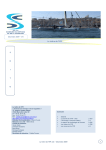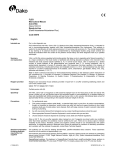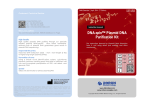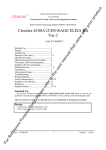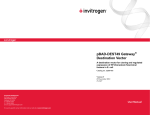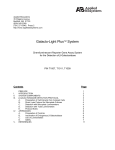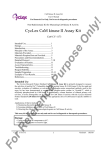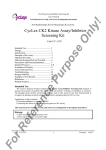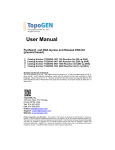Download EnterokinaseMax (EKMax ) - Thermo Fisher Scientific
Transcript
EnterokinaseMax™ (EKMax™) Catalog nos. E180-01, E180-02 Version H 16 June 2006 25-0110 Corporate Headquarters Invitrogen Corporation 1600 Faraday Avenue Carlsbad, CA 92008 T: 1 760 603 7200 F: 1 760 602 6500 E: [email protected] For country-specific contact information visit our web site at www.invitrogen.com User Manual ii Table of Contents Table of Contents ................................................................................................................................................. iii Important Information ........................................................................................................................................ iv Methods.......................................................................................................................................................................1 Overview.................................................................................................................................................................1 EKMax™ Digestion.................................................................................................................................................2 Appendix.....................................................................................................................................................................6 Recipes.....................................................................................................................................................................6 Technical Service....................................................................................................................................................7 References ...............................................................................................................................................................8 iii Important Information Shipping/Storage EnterokinaseMax™ and the 10X EKMax™ reaction buffer are shipped on blue ice and should be stored at -20°C. Contents EKMax™ in 50 mM potassium phosphate, pH 8.0, 500 mM NaCl and 50% glycerol, is supplied as follows: Catalog no. E180-01: Item Amount EKMax™ 250 µl 250 units, 1 unit/µl ™ 10X EKMax Reaction Buffer Volume 500 mM Tris-HCl, pH 8.0 (22°C), 10 mM CaCl2, 1% Tween-20 1.5 ml Catalog no. E180-02: Item Amount ™ Volume EKMax 1000 units, 1 unit/µl 1.0 ml 10X EKMax™ Reaction Buffer 500 mM Tris-HCl, pH 8.0 (22°C), 10 mM CaCl2, 1% Tween-20 3 x 1.5 ml Additional Materials Needed You will need to have the following materials: • 37°C water bath or heat block • Deionized water • 1.5 ml microcentrifuge tubes • SDS-PAGE apparatus and buffers (see page 4 for guidelines) • EK-Away™ Resin and buffers (Invitrogen, Catalog no. R180-01) • 15 ml polypropylene tubes (optional) • Chromatography columns (optional, Catalog no. R640-50) • Rocker or rotator Unit Definition 1 unit is defined as the amount of EKMax™ that will digest 20 µg of BioEase™ Mog1 (multicopy suppressor of GSP1, 1) fusion protein to 90% completion in 20 minutes at 37°C in 50 mM Tris-HCl, pH 8.0, 1 mM CaCl2, and 0.1% Tween-20 (1X EKMax™ Buffer). For comparison purposes, 1 Invitrogen unit of EKMax™ = ~190 trypsinogen activation units. Use this conversion only as a rough estimate of how much EKMax™ to use. It is important to empirically determine the optimal amount of EKMax™ to digest your fusion protein (see page 2). Limited Label License No. 62: EKMax™ Enterokinase This product is sold under patent license from Genetics Institute, Inc. for Research Use Only. Licenses for commercial manufacture or use may be obtained from Genetics Institute, Inc. iv Methods Overview Introduction Enterokinase is a highly specific serine protease that can be used to digest fusion proteins to release the fusion partner or tag from the desired protein. The enzyme recognizes the sequence -(Asp)4 Lys and cleaves after the lysine residue. This cleavage sequence is present in many expression vectors available from Invitrogen (contact Technical Service for more information). Genes cloned into the multiple cloning site of these vectors express recombinant N-terminal fusion proteins. The native proteins can be released from the N-terminal fusion peptide or protein by digesting with enterokinase. EnterokinaseMax™ (EKMax™) is a specially prepared recombinant enzyme, consisting of the catalytic subunit of the holoenzyme. This subunit is expressed and purified from the yeast, Pichia pastoris, yielding an enzyme with higher specific activity. This results in more efficient cleavage using less enzyme. Description of Enterokinase Enterokinase (enteropeptidase EC 3.4.21.9) is the physiological activator of trypsinogen and a serine protease that exhibits specificity for the sequence (Asp)4 Lys (Anderson et al., 1977). The bovine holoenzyme is a heterodimer consisting of a 115 kDa structural subunit and a 35 kDa catalytic subunit. The larger subunit acts as a membrane anchor and positions the catalytic subunit on the luminal side of the brush border membrane. The catalytic subunit is homologous to other serine proteases and is inhibited by chemical modification of the serine and histidine active site residues (Grant and Hermon-Taylor, 1977; Light and Liepnieks, 1979; Maroux et al., 1971). Specificity of Enterokinase It has been proposed that the active center of enterokinase possesses a distinctive cationic subsite that binds -(Asp)4. Enterokinase is highly specific and tolerates very few changes to its recognition site. If the ionic charge of the recognition site is preserved, enterokinase will recognize the site, but the rate of hydrolysis of the peptide bond will be reduced (Light and Janska, 1989). The four aspartyl residues act as a signal for enterokinase cleavage. It has been reported that with only three aspartyl residues the rate of hydrolysis is reduced. Two aspartyl residues preceding the lysyl residue are the minimum number of acidic residues needed to maintain specificity (Maroux et al., 1971). Non-specific cleavage by enterokinase may occur in the cases described above, but this is usually alleviated by reducing the amount of enzyme used. Expression of the Recombinant Catalytic Subunit EKMax™ is a clone of the catalytic subunit of enterokinase (LaVallie et al., 1993) expressed in the yeast Pichia pastoris. EKMax™ is secreted into the medium, purified, and migrates at 43 kDa on an SDS-PAGE gel. The calculated molecular weight of the protein is 26.3 kDa, but it contains three sites for asparagine-linked glycosylation. The apparent molecular weight of 43 kDa is consistent with previous observations (LaVallie et al., 1993) and is assumed to be because of N-linked glycosylation. 1 EKMax™ Digestion Introduction You will need to have pure or partially pure fusion protein. This section describes how to digest the fusion protein with EKMax™ to cleave your protein from the fusion partner. This requires setting up a series of pilot reactions to determine empirically the best conditions for digestion. The efficiency of cleavage of EKMax™ will differ with each fusion protein. Also, if you are accustomed to using EK3 (Biozyme), it is still necessary to test different concentrations of EKMax™ to determine the right amount for complete digestion. The table below outlines the steps needed to digest your fusion protein and obtain pure protein. Stage Additional Materials Needed Important Description 1 Obtain purified fusion protein at a concentration of > 0.1 mg/ml 2 Dialyze (if necessary) into 1X EKMax™ Buffer 3 Set up pilot reactions using different amounts of EKMax™ and digest overnight 4 Assay reactions on an SDS-PAGE gel and analyze 5 Optimize digestion conditions by adjusting amount of enzyme or the temperature as needed 6 Scale-up digestions to produce more of your native protein 7 Purify your native protein away from the fusion partner and EKMax™ You will need to have the following materials: • 37°C water bath or heat block • Deionized water • 1.5 ml microcentrifuge tubes • SDS-PAGE apparatus and buffers (see page 4 for guidelines) • EK-Away™ Resin and buffers (Invitrogen, Catalog no. R180-01) • 15 ml snap-cap polypropylene tubes (optional) • Chromatography columns (optional, Catalog no. R640-50) • Rocker or rotator We have found that EKMax™ will digest fusion proteins bound to their respective affinity columns, releasing the desired protein and leaving the fusion partner bound to the column. For methods to digest Xpress™ fusions bound to ProBond™ and thioredoxin fusion proteins in situ on ThioBond™, contact Technical Service (see page 7). continued on next page 2 EKMax™ Digestion, continued Obtain Purified Fusion Protein Purify at least 120 µg of your fusion protein using your system of choice following the manufacturer's instructions. • To purify thioredoxin fusion proteins, refer to the ThioBond™ manual included with the ThioBond™ resin or contact Invitrogen for information. • To purify Xpress™ fusion proteins, refer to the ProBond™ Purification System manual or contact Invitrogen for information Note: Both manuals may be downloaded from www.invitrogen.com. EKMax™ will digest fusion proteins in crude cell lysates. Note however, that you will lose your fusion tag and will have to develop a separate protocol for purification of your protein. Dialysis of the Fusion Protein It may be necessary to dialyze your fusion protein against 1X EKMax™ buffer (see Recipes, page 6) before digesting it with EKMax™. EKMax™ is inhibited by high ionic strength. 250 mM NaCl reduces EKMax™ activity to 75% of normal and 2 M NaCl almost completely inhibits enzyme activity (Barratti et al., 1973). Also, EKMax™ is known to be inhibited by > 2 M urea, > 20 mM β-mercaptoethanol (β-ME), >0.1% SDS, > 50 mM imidazole, and pH values below 6 and above 9. Use the table below to determine if you need to dialyze your fusion protein prior to digestion with EKMax™. If your purified protein .... Recommendation Then ...... contains > 2 M urea, > 250 mM NaCl, > 20 mM -ME, 0.1% SDS, or > 50 mM imidazole dialyze to remove the inhibitors is in a buffer where the pH is lower than 6 or higher than 9 dialyze to adjust the pH to between 6 and 9. is free from inhibitors and the pH is between 6 and 9 do not dialyze. Proceed straight to Preparation of Pilot Reactions, below. If you are not sure whether you should dialyze your protein or not, dialyze a small volume of your protein solution and test both dialyzed and undialyzed samples in a pilot EKMax™ digestion. continued on next page 3 EKMax™ Digestion, continued Preparation of Pilot Reactions You will need at least 120 µg of your fusion protein for the pilot reactions. The ratio of enzyme to fusion protein to achieve complete digestion may vary depending on the protein expressed. It is very important to use only the minimal amount of EKMax™ necessary to completely digest the fusion protein. Excess EKMax™ may cause non-specific cleavage of your fusion protein in some cases. 1. To determine the optimal units of EKMax™ needed for complete digestion, use five different amounts of EKMax™ (4 units, 1 unit, 0.1 unit, 0.01 unit, and 0.001 unit). For 4 units of EKMax™, use 4 µl of undiluted EKMax™. Use 1X EKMax™ buffer to make serial 10-fold dilutions of the enzyme. 2. Set up 6 reactions, including a reaction without EKMax™ to control for proteases in your protein solution: Fusion Protein 10X EKMax™ Buffer EKMax™ Deionized Water (use 30 µl for the no EKMax™ control) Final Volume 20 µg 3 µl 1-4 µl to 29 µl 30 µl 3. Mix well and incubate at 37°C overnight (~16 hours). If your protein is unstable and degrades at 37°C, try incubation at 22°C, 16°C, or +4°C. It is not necessary to increase the time of digestion to compensate for the decrease in temperature. 4. Prepare and load 1-20 µl on an SDS-PAGE gel (see next section). For western blotting, load ~1 µg of your fusion protein, and for Coomassie-stained gels, load ~10 µg. If you wish to digest your fusion protein in a crude lysate, be sure to dialyze to remove any inhibitors of EKMax™. Set up your pilot reactions as described above to determine the amount of EKMax™ needed to digest your fusion protein. SDS-PAGE Analysis Use an SDS-PAGE gel that will allow you to differentiate between undigested and digested fusion protein. The type of gel and concentration of acrylamide depends on the size of your fusion protein and the fusion partner. Some fusion partners will be too small to resolve conveniently (i.e. the Xpress™ tag). You should be able to distinguish the removal of the fusion partner from your protein, either by Coomassie-staining or by using antibody detection methods. Choose the dilution of EKMax™ that gives you complete digestion of your recombinant fusion protein. Recommendation for Thioredoxin Fusion Proteins A Tricine gradient gel may be necessary to visualize the 14.6 kDa thioredoxin fusion partner (Schagger and von Jagow, 1987). Alternatively, a western blot using the Anti-Thio™ Antibody (Catalog no. R920-25) may be used to detect the accumulation of the thioredoxin fusion partner and/or subsequent loss of signal from the native protein. continued on next page 4 EKMax™ Digestion, continued Recommendation for Xpress™ Fusion Proteins Since the Xpress™ peptide is less than 4 kDa, a shift in the size of your protein may be undetectable. A western blot using the Anti-Xpress™ Antibody (Catalog no. R910-25) or the Anti-Xpress™-HRP Antibody (Catalog no. R911-25) may be necessary to visualize the cleavage and removal of the Xpress™ fusion peptide from fusion proteins. Perform a western blot and look for the loss of the signal from your protein. The Xpress™ peptide is so small, it may not transfer well to nitrocellulose or nylon, making it difficult to detect. Optimizing EKMax™ Cleavage In some cases, increasing the calcium chloride concentration to 10 mM or the amount of Tween-20 to 1% in the digestion reaction increases the activity of EKMax™. There is a possibility that EKMax™ may recognize sites that are similar to its recognition site; however, the rate of hydrolysis will be reduced. This is usually alleviated by decreasing the amount of EKMax™. Scale-Up of EKMax™ Reaction After you have optimized the EKMax™ reaction, you may scale up your digestion reaction in a linear manner. You may need a concentrated solution of fusion protein in order to scale up your digestion. Use standard ultrafiltration methods to concentrate your protein solution. Removal of EKMax™ After digestion, EKMax™ may be removed by affinity chromatography on soybean trypsin inhibitor (STI) resin. For easy removal of EKMax™, EK-Away™ Resin (Catalog no. R180-01) is available from Invitrogen. EK-Away™ Resin consists of soybean trypsin inhibitor immobilized on 4% beaded agarose. For a protocol to use EK-Away™ Resin, refer to the EK-Away™ manual. The manual is available at www.invitrogen.com or contacting Technical Service (see page 7). Removal of Fusion Fusion partners may be removed by the same affinity resin as was used to purify the fusion protein. For protocols to remove the Xpress™ tag or the thioredoxin Partners fusion partner after EKMax™ digestion, contact Technical Service (see page 7). For other fusion proteins, consult the manufacturer of your particular system. 5 Appendix Recipes 10X EKMax™ Reaction Buffer 6 500 mM Tris-HCl, pH 8.0 10 mM CaCl2 1% Tween-20 (v/v) 1. For 1 liter, dissolve 60.5 g Tris base in 950 ml deionized water. 2. Adjust pH to 8.0 with concentrated HCl. 3. Add 1.47 g CaCl2-2H2O and 10 ml Tween-20 and mix. 4. Adjust the volume to 1 liter. Store at room temperature. Technical Service Web Resources Visit the Invitrogen website at www.invitrogen.com for: • Technical resources, including manuals, vector maps and sequences, application notes, MSDSs, FAQs, formulations, citations, handbooks, etc. • Complete technical service contact information • Access to the Invitrogen Online Catalog • Additional product information and special offers Contact Us For more information or technical assistance, call, write, fax, or email. Additional international offices are listed on our website (www.invitrogen.com). Corporate Headquarters: Invitrogen Corporation 1600 Faraday Avenue Carlsbad, CA 92008 USA Tel: 1 760 603 7200 Tel (Toll Free): 1 800 955 6288 Fax: 1 760 602 6500 E-mail: [email protected] Japanese Headquarters: Invitrogen Japan LOOP-X Bldg. 6F 3-9-15, Kaigan Minato-ku, Tokyo 108-0022 Tel: 81 3 5730 6509 Fax: 81 3 5730 6519 E-mail: [email protected] European Headquarters: Invitrogen Ltd Inchinnan Business Park 3 Fountain Drive Paisley PA4 9RF, UK Tel: +44 (0) 141 814 6100 Tech Fax: +44 (0) 141 814 6117 E-mail: [email protected] MSDS MSDSs (Material Safety Data Sheets) are available on our website at www.invitrogen.com/msds. Limited Warranty Invitrogen is committed to providing our customers with high-quality goods and services. Our goal is to ensure that every customer is 100% satisfied with our products and our service. If you should have any questions or concerns about an Invitrogen product or service, contact our Technical Service Representatives. Invitrogen warrants that all of its products will perform according to specifications stated on the certificate of analysis. The company will replace, free of charge, any product that does not meet those specifications. This warranty limits Invitrogen Corporation’s liability only to the cost of the product. No warranty is granted for products beyond their listed expiration date. No warranty is applicable unless all product components are stored in accordance with instructions. Invitrogen reserves the right to select the method(s) used to analyze a product unless Invitrogen agrees to a specified method in writing prior to acceptance of the order. Invitrogen makes every effort to ensure the accuracy of its publications, but realizes that the occasional typographical or other error is inevitable. Therefore Invitrogen makes no warranty of any kind regarding the contents of any publications or documentation. If you discover an error in any of our publications, please report it to our Technical Service Representatives. Invitrogen assumes no responsibility or liability for any special, incidental, indirect or consequential loss or damage whatsoever. The above limited warranty is sole and exclusive. No other warranty is made, whether expressed or implied, including any warranty of merchantability or fitness for a particular purpose. continued on next page 7 References Anderson, L. E., Walsh, K. A., and Neurath, H. (1977). Bovine Enterokinase. Purification, Specificity, and Some Molecular Properties. Biochemistry 16, 3354-3360. Barratti, J., Maroux, S., and Louvard, D. (1973). Effect of Ionic Strength and Calcium Ions on the Activation of Trypsinogen by Enterokinase. A Modified Test for the Quantitative Evaluation of the Enzyme. Biochem. Biophys. ACTA 321, 632-638. Grant, D. A. W., and Hermon-Taylor, J. (1977). Hydrolysis of Artificial Substrates by Enterokinase and Trypsin and the Development of a Sensitive Specific Assay for Enterokinase in Serum. Biochem J. 155, 243-254. LaVallie, E. R., Rehemtulla, A., Racie, L. A., Diblasio, E. A., Ferenz, C., Grant, K. L., Light, A., and McCoy, J. M. (1993). Cloning and Functional Expression of a cDNA Encoding the Catalytic Subunit of Bovine Enterokinase. J. Biol. Chem. 268, 23311-23317. Light, A., and Janska, H. (1989). Enterokinase (enteropeptidase): Comparative Aspects. TIBS 14, 110-112. Light, A., and Liepnieks, J. J. (1979). The Preparation and Purification of Bovine Enterokinase. J. Biol. Chem. 254, 1677-1683. Maroux, S., Baratti, J., and Desnuelle, P. (1971). Purification and Specificity of Porcine Enterokinase. J. Biol. Chem. 246, 5031-5039. Schagger, H., and von Jagow, G. (1987). Tricine-Sodium dodecyl sulfate-Polyacrylamide Gel Electrophoresis for the Separation of Proteins in the Range from 1 to 100 kDa. Anal. Biochem. 166, 368-379. ©1998-2006 Invitrogen Corporation. All rights reserved. For research use only. Not intended for any animal or human therapeutic or diagnostic use. 8 Corporate Headquarters Invitrogen Corporation 1600 Faraday Avenue Carlsbad, CA 92008 T: 1 760 603 7200 F: 1 760 602 6500 E: [email protected] For country-specific contact information visit our web site at www.invitrogen.com User Manual
















